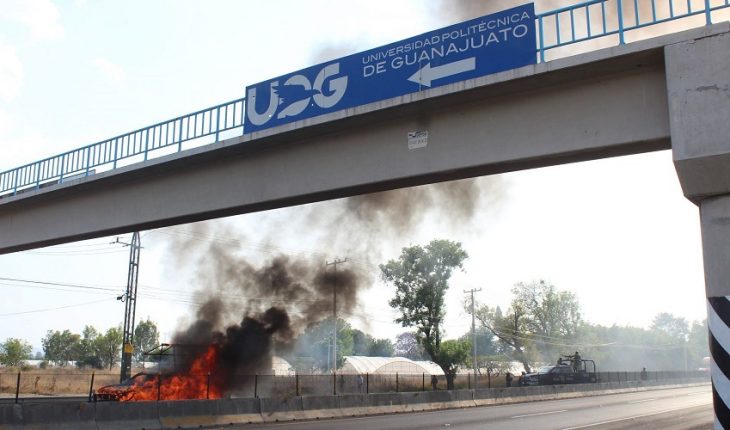Guanajuato goes through critical moments. In the last seven days, nearly 100 people have been killed in the state, including four policemen, amid clashes, ambushes, direct attacks, grenade attacks, and threats from criminal groups to extend their war to the latest consequences.
The crisis of violence has become widespread in the entity. The official parts of the State Attorney General’s Office have, just this week, carried out murders and attacks in 14 different municipalities in all regions of Guanajuato.
Read more: 8 people killed in Apaseo el Alto, Guanajuato
80% of homicides, according to estimates from the Federal Security Cabinet, are directly related to organized crime and in particular to the dispute between rival cartels. Just last Monday one of these groups placed giant blankets in 13 mayors to threaten their opponents and all who support them.
David Saucedo, analyst and security consultant in Guanajuato, says the outbreak of violence stems in 2014, when members of the Jalisco Nueva Generación Cartel (CNJG) broke into the entity, breaking a kind of truce that existed between local cartels. From there the escalation of violence has not stopped.
Official data confirms this. From 2015 to 2020, the number of murders has soared almost 448%. It is an increase in homicidal violence, sustained year after year, that has not been presented in any other state.
There are municipalities, says the specialist, that are totally co-opted by organized crime with everything and municipal governments. “Cartels put and take away officials, they don’t just handle criminal activities,” he warned.
What about the security authorities? Local forces search 40 policemen killed so far this year, more than any other state. They are outnumbered and in firepower by criminal organizations.
At the federal level, meanwhile, deployment has had no greater impact, which has already caused annoyance at higher cabinet levels. A few weeks ago the heads of the military zone and the National Guard were ordered to be changed in an attempt to turn the strategy around.
Violent times
Security figures published daily by the security cabinet show that 93 people were killed in Guanajuato between 27 May and 2 June. If you take into account that being a real-time count has a sub-registration of 10 to 20%, the homicide figure is higher than 100 cases in this period.
Last Tuesday, June 2nd, 20 murders were recorded in the preliminary count, which ranks this day among the five most violent of the year.
According to the official parties, among the attacks recorded last Tuesday is an aggression outside a vulcanizer on the pan-American highway between Celaya and Salamanca in which grenades were detonated that generated a fire and firearms were fired. The balance was two people killed.
This is not the first time such explosives have been used in attacks in the state. Just on the night of March 23rd a commando attacked the “Negros Bar” establishment in Celaya with firearms and at least two grenades. The balance on that day was four dead and six people injured.
Another multi-homicide was also recorded in the early morning of January 2. Six people who were eating at a food stall on Highway 2190 at the height of the municipality of San Luis de la Paz were shot dead by armed subjects who simply arrived and shot them.
Policemen have also been among the victims of the assaults recorded in the last week. On 1 June, three Ministerial Police officers of the entity who were on a stage stage in the Fractionation of the Forest colony in Celaya were ambushed by several subjects who shot them on multiple occasions.
The balance of the attack was of two policemen killed by head injuries, while a third 26-year-old was also injured, but survived, and moved to a hospital where he is stable. The attack was such that two vans at the point were hit by several hits.
A day earlier, in the same municipality of Celaya, two municipal policemen were attacked with multiple shots while inside a black Jetta model car, with Mexico City plates, on Avenida Irrigación. None of them survived.
In total, the State Prosecutor’s Office reported only in the last week different acts of violence in 14 municipalities: León, Celaya, IRapuato, Silao, Acámbaro, Uriangato, Dolores Hidalgo, San Luis de la Paz, Jerécuaro, Salamanca, Moroleón, Victoria, San Diego de la Unión and San Miguel de Allende.
Find out: In the middle of the pandemic homicides go up in 18 states and add more than 6,000 murders
On the other hand, figures from the Executive Secretariat of the National Public Security System (SESNSP) show that in the first quarter of 2020, 1,534 victims of wilful homicide were reported in Guanajuato, equivalent to a growth of almost 448% of murders over a five-year period.
The curve of homicidal violence has been ascending and sustained. While 280 victims of manslaughter were reported in the first quarter of 2015, by 2016 the figure grew to 297; in 2017, cases grew to 455; in 2018 they soared to 1 thousand 4. By 2019, the killings from January to April continued to rise with 1 thousand 237 cases.
The level of violence in 2020 in Guanajuato is such that the 1 thousand 534 murders recorded in the first quarter represent 13% of all murders committed in the country, at least 1 in 10 homicides committed in Mexico occur in Guanajuato.
Among the victims who have taken on violence in the state are dozens of police officers. Data from the organization Cause in Common indicate that until 31 May 38 local public and investigative security agents had been killed. To those who already join two more registered on June 1.
This is, and by far, the state that records the most local police killed in 2020. He is followed by Chihuahua with 20 policemen who are down in the line of duty, and Veracruz with 19.
Regardless of confinement, the murders in Mexico are still on the rise. Here is the behavior of this crime in the first quarter of the year. ? pic.twitter.com/H3zhgRGDV9
— Common Cause (@causaencomun) June 2, 2020
The narco-war, its stages and the change of command
This June 3, President Andrés Manuel López Obrador acknowledged at his regular press conference that homicides are a security issue that the government has not yet managed to solve, but highlighted Guanajuato as the red spotlight. Proof of that, he said, is that the state concentrated 28% of the homicides on June 2.
The president attributed such violence to the confrontation between criminal groups that he did not mention by name, but said they are holding a strong dispute over the territory, a conflict inherited since the past six-year-old.
Facts and specialists right the president. Just last Monday, the criminal group called the Santa Rosa de Lima Cartel (CSRL) placed blankets in 13 different municipalities, including Celaya, Irapuato, Silao and Salamanca, where they warn that they will murder members of the Jalisco Nueva Generación Cartel (CJNG) and all those who support them.
Estimates from the federal security cabinet show that at least 8 out of 10 homicides reported daily in Guanajuato are linked to organized crime, rather than in any other state.
“What’s here is a war, a war that has been very protracted that began more than five years ago but has been getting worse. A war where local authorities have been infiltrated and overstepped, while the feds have failed to put a stop,” says security consultant David Saucedo.
The expert explains that this conflict has gone through three phases. The first began when the CJNG decided at the end of 2014 to begin an aggressive expansion in the country, which in Guanajuato translated as an invasion of territories that, at the time, were controlled by local groups that maintained a non-aggression pact. Among these groups were, for example, the CSRL, the “Lion Union”, remnants of the Knights Templar, Los Zetas, among others.
Saucedo explains that local authorities opted for a kind of “retraction,” waiting for a group to take control and win the dispute, which in other states like Guerrero has brought a drop in homicides. The problem is that in Guanajuato that didn’t happen: disputes between groups continued without a clear victor and the killings began to escalate.
The second phase of “war” began in 2019 when the current federal government prioritized combating fuel theft, a criminal activity that in Guanajuato was under almost exclusive control of the CSRL led by José Antinio Yepez, el Marro. This caused the official offensive to focus against that specific group, which was taken advantage of by its rivals to expand.
And the new problem, Saucedo stresses, is that the government also failed to disarm the CSRL and stop “El Marro”, while the CJNG was empowered into the entity.
By 2020 the conflict in Guanajuato it reaches a third phase where federal forces are now trying to fight at least the two major cartels, which in turn has been leveraged by the CSRL to move from a defensive position to a renewed offensive. And thus recover territories.
In fact, Saucedo details, the criminal groups in Guanajuato are not weaker than a few years ago, but the opposite. It explains, for example, that csrL has a presence in 20 municipalities in the state, and in eight of them its presence is hegemonic to the point of having control of key posts in governments
“He controls police management, manages public works budgets, and appoints high-ranking officials from municipal governments. The willingness of mayors to ‘work’ under this scheme is irrelevant. Some do so on threatening terms and others under a mutually beneficial alliance,” the expert concludes.
What is the picture coming for Guanajuato? Saucedo says a new strategy is required and soon. While the presence of armed forces and the National Guard has so far increased, it has had no impact to curb violence. Even health contingency didn’t have any effect.
A good sign is the recent change of federal commanders in the state. In May, the commander-in-chief of the National Guard was removed in the state of José Martin Luna, and instead was appointed Commissioner Héctor Ortiz Caletty. In the same way, General Norberto Cortes Rodriguez was appointed as the new commander of the XII Military Region in Guanajuato.
“These changes confirm that all actions implemented in 2019 and at this year’s start were a failure. Let’s hope there’s a new strategy now because defeating the cartels is not an immediate thing, it takes two or three years. The picture is not encouraging,” he concluded.
What we do in Animal Político requires professional journalists, teamwork, dialogue with readers and something very important: independence. You can help us keep going. Be part of the team.
Subscribe to Animal Político, receive benefits and support free journalism #YoSoyAnimal.





